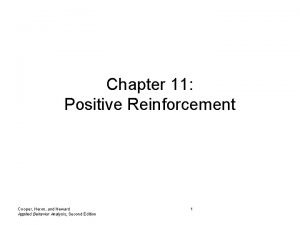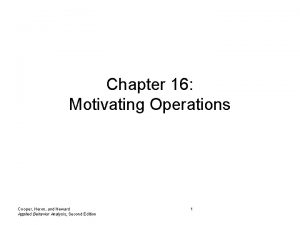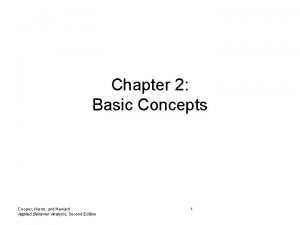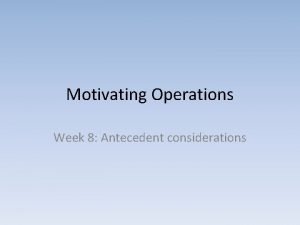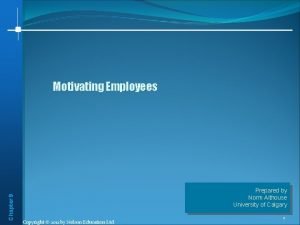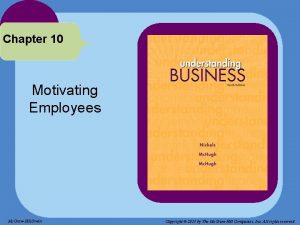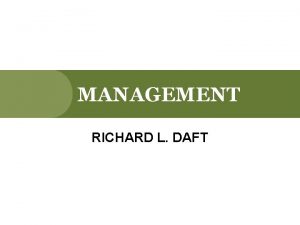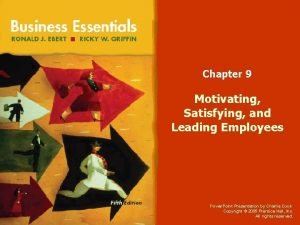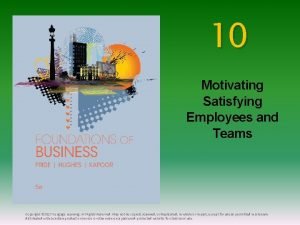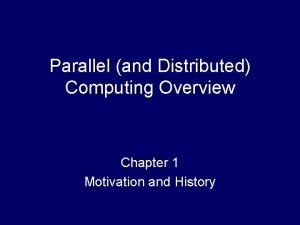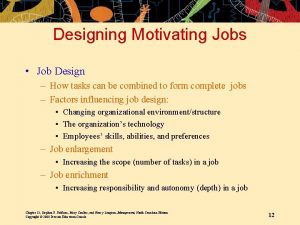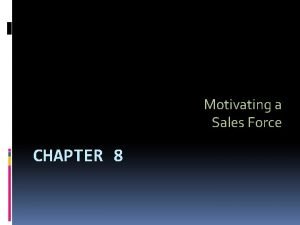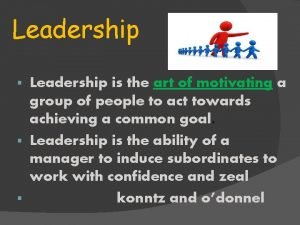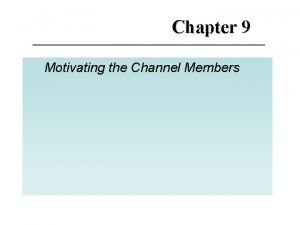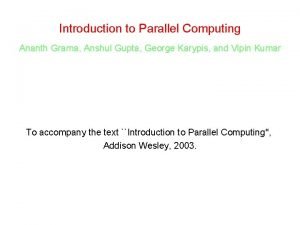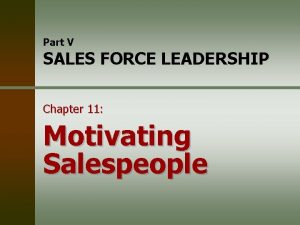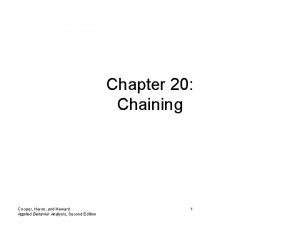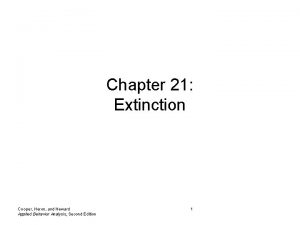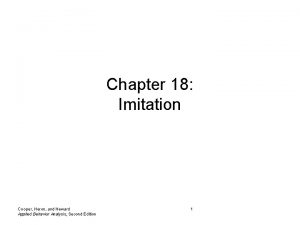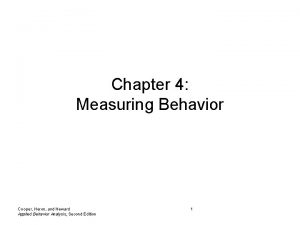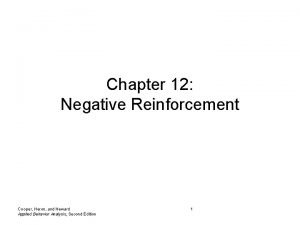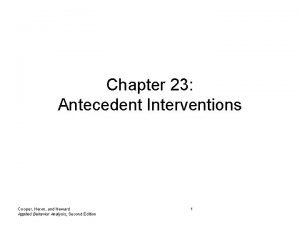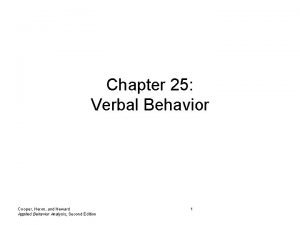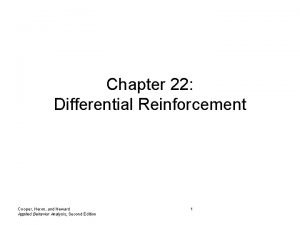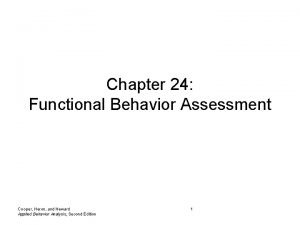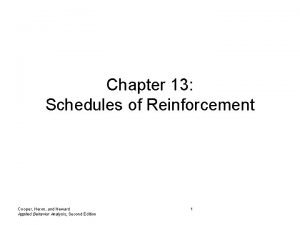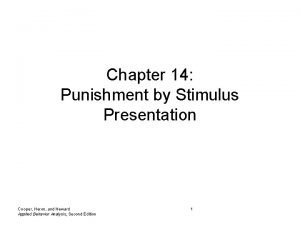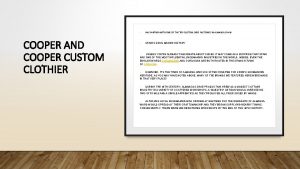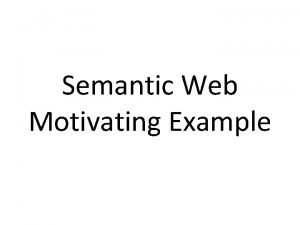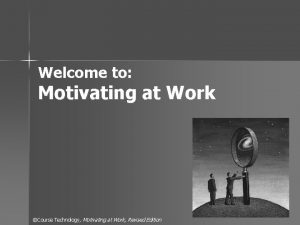Chapter 16 Motivating Operations Cooper Heron and Heward






























- Slides: 30

Chapter 16: Motivating Operations Cooper, Heron, and Heward Applied Behavior Analysis, Second Edition 1

Motivating Operations • Establishing Operations (EO) – Keller & Schoenfeld (1950) • Drive concept: relation between environmental variables – Reintroduced (Michael 1982): any environmental variable that: • Alters the effectiveness of some object or event as a reinforcer • Alters the current frequency of all behavior that has been reinforced by that stimulus, object, or event Cooper, Heron, and Heward Applied Behavior Analysis, Second Edition 2

Motivating Operations • EO commonly used applied behavior analysis • Motivating Operation (MO) suggested to replace term EO along with the terms: – Value altering – Behavior altering Cooper, Heron, and Heward Applied Behavior Analysis, Second Edition Describe the defining effects in the original definition of EO 3

Value-altering Effects • Value-altering effects: – An increase in the reinforcing effectiveness of some stimulus, object, or event • MO = EO – A decrease in reinforcing effectiveness of some stimulus, object, or event • MO = abolishing operation (AO) Cooper, Heron, and Heward Applied Behavior Analysis, Second Edition 4

Behavior-altering Effects • Behavior-altering effects: – Evocative effect • Increase in the current frequency of behavior that has been reinforced by some stimulus, object, or event – Abative effect • Decrease in the current frequency of behavior that has been reinforced by some stimulus, object, or event Cooper, Heron, and Heward Applied Behavior Analysis, Second Edition 5

Behavior-altering Effects • Direct and indirect effects • Frequency of behavior result of: – Direct evocative or abative effect of the MO on response frequency – Indirect effect on the evocative or abative strength of relevant SD’s • Value-altering effects may also occur for conditioned reinforcers conditioned MO’s Cooper, Heron, and Heward Applied Behavior Analysis, Second Edition 6

Behavior-altering effects • Dimensions of behavior-altering effects – Not limited to frequency – Other examples: • Response magnitude • Response latency • Relative frequency Cooper, Heron, and Heward Applied Behavior Analysis, Second Edition 7

Motivating Operations • Behavior-altering effects should not be interpreted as a result of the organism encountering more or less effective forms of reinforcement – Strong relating exists between MO level & responding in extinction • MO should evoke the behavior even if it is not at first successful Cooper, Heron, and Heward Applied Behavior Analysis, Second Edition 8

Motivating Operations • Behavior-altering effects – Operate on the current frequency of the behavior – Antecedent variables (i. e. MO’s, SD’s ) – Can evoke or abate responses, but not alter them • Function-altering effects – Operate on the future frequency of the behavior – Consequence variables (i. e. reinforcers, punishers, extinction procedure, recovery from punishment procedure) – Change repertoire of functional relations Cooper, Heron, and Heward Applied Behavior Analysis, Second Edition 9

Motivating Operations • Antecedent variables – MO’s and SD’s – Alter the current frequency of the behavior – Operant variables • Control response frequency due to their relation to reinforcing or punishing consequences Cooper, Heron, and Heward Applied Behavior Analysis, Second Edition 10

Antecedent Variables • SD – Related to the differential availability of a currently effective form of reinforcement for a particular type of behavior • MO – Related to the differential reinforcing effectiveness of a particular type of environmental event Cooper, Heron, and Heward Applied Behavior Analysis, Second Edition 11

Motivating Operations • Unconditioned Motivating Operations (UMO’s) – Value-altering motivating effects that are unlearned • Conditioned Motivating Operations (CMO’s) – Value-altering motivating effects that are a function of a learning history Cooper, Heron, and Heward Applied Behavior Analysis, Second Edition 12

Unconditioned Motivating Operations (UMO’s) • UMO’s for humans: – Deprivation and satiation UMO’s – UMO’s relevant to sexual reinforcement – Temperature changes – Painful stimulation Cooper, Heron, and Heward Applied Behavior Analysis, Second Edition 13

Unconditioned Motivating Operations (UMO’s) • Deprivation and satiation UMO’s – Deprivation of food, water, oxygen, activity, & sleep = reinforcer-establishing & evocative effects – Ingestion of food and water, oxygen intake, engaging in activity, & sleeping = reinforcerabolishing & abative effects Cooper, Heron, and Heward Applied Behavior Analysis, Second Edition 14

Unconditioned Motivating Operations (UMO’s) • UMO’s relevant to sexual reinforcement – Learning plays a strong role in the determination of sexual behavior (different from nonhuman mammals), difficult to determine what is unlearned – For humans organisms: • Role of hormones & chemical attractants in unclear • Tactile stimulation of erogenous body areas • Passage of time since last sexual activity – establishing & evocative effects • Sexual orgasm – abolishing & abative effects Cooper, Heron, and Heward Applied Behavior Analysis, Second Edition 15

Unconditioned Motivating Operations (UMO’s) – Temperature Changes Cooper, Heron, and Heward Applied Behavior Analysis, Second Edition 16

Unconditioned Motivating Operations (UMO’s) • Painful Stimulation – Increase establishes pain reduction as reinforcer & evokes escape behavior – Decrease abolishes effectiveness of pain reduction as a reinforcer & abates behavior that has been reinforced by pain reduction – Evokes aggressive behavior toward another organism when in the presence of that organism Cooper, Heron, and Heward Applied Behavior Analysis, Second Edition 17

Unconditioned Motivating Operations (UMO’s) • Important considerations: – Individuals do not have “understand” anything for an MO to have value-altering & behavior-altering effects – Relevant MO must be in effect in future circumstances if behavior is to occur Cooper, Heron, and Heward Applied Behavior Analysis, Second Edition 18

Unconditioned Motivating Operations (UMO’s) • Weakening effects of an EO may be necessary – Reinforcer-establishing & evocative effects of UMO’s can be temporarily weakened • Reinfocer-abolishing operations • Abative operations – Cannot permanently weaken value-altering effects of UMO’s – Behavior-altering effects are based on history of reinforcement Cooper, Heron, and Heward Applied Behavior Analysis, Second Edition 19

Unconditioned Motivating Operations (UMO’s) • UMO’s for Punishment – Value-altering effect does not depend on a learning history – Most punishers affecting humans are conditioned – involves a learning history • UMO-CMO relation • Same MO’s for reinforcers as conditioned punishers – Reinforcer must be effective if deprivation or removal will function as a punisher Cooper, Heron, and Heward Applied Behavior Analysis, Second Edition 20

Unconditioned Motivating Operations (UMO’s) • Behavior-altering effects are more complex in observing a punishment effect than a reinforcement effect – Must consider the status of the variable responsible for the occurrence of the punished behavior – Complex behavioral relations Cooper, Heron, and Heward Applied Behavior Analysis, Second Edition 21

Unconditioned Motivating Operations (UMO’s) • Environmental events will have both – Behavior-altering effects on current frequency of the behavior – Function-altering effects (as consequences) on future frequency of the behavior that preceded the onset of the event Cooper, Heron, and Heward Applied Behavior Analysis, Second Edition 22

Conditioned Motivating Operations (CMO’s) • Motivating variables that alter the reinforcing effectiveness of other stimuli, objects, or events, only as a result of the organism’s learning history • Alter the momentary frequency of all behavior that has been reinforced by those other events (like UMO’s) Cooper, Heron, and Heward Applied Behavior Analysis, Second Edition 23

Conditioned Motivating Operations (CMO’s) • Three types of CMO’s – Surrogate (CMO-S) – Reflexive (CMO-R) – Transitive (CMO-T) • All are motivationally neutral stimuli prior to their relation with another MO or to a form of reinforcement or punishment Cooper, Heron, and Heward Applied Behavior Analysis, Second Edition 24

Conditioned Motivating Operations (CMO’s) • Surrogate CMO (CMO-S) – Accomplishes what the MO it was paired with accomplishes – Has the same value-altering and behavior altering effects as the MO it was paired with – CMO-S – Can be altered in its effects by through pairing and unpairing Cooper, Heron, and Heward Applied Behavior Analysis, Second Edition 25

Conditioned Motivating Operations (CMO’s) • Reflexive CMO (CMO-R) – Alters a relation to itself – Acquires MO effectiveness by preceding some form of worsening or improvement – CMO-R – Exemplified by warning stimulus in a typical escape-avoidance procedure • Establishes its own offset as reinforcement and evokes all behavior that has accomplished that offset Cooper, Heron, and Heward Applied Behavior Analysis, Second Edition 26

Conditioned Motivating Operations (CMO’s) • Transitive CMO (CMO-T) – Makes something else effective as reinforcement because of its relation or association to the unconditioned reinforcer – Environmental variable that establishes or abolishes the reinforcing effectiveness of another stimulus and evokes or abated the behavior that has been reinforced by the other stimulus – CMO-T Cooper, Heron, and Heward Applied Behavior Analysis, Second Edition 27

Conditioned Motivating Operations (CMO’s) • Transitive CMO (CMO-T) – All variables that function as UMO’s also function as CMO-T for the stimuli that are conditioned reinforcers because of their relation to the relevant unconditioned reinforcer Cooper, Heron, and Heward Applied Behavior Analysis, Second Edition 28

Conditioned Motivating Operations (CMO’s) • Transitive CMO (CMO-T) – Often confused with SD • Distinction between SD & CMO-T lies in the relation between reinforcer availability & presence or absence of the stimulus • SD: if reinforcer is more available in the presence than in the absence of the stimulus • CMO-T: if reinforcer is just as available in the absence as in the presence of the stimulus Cooper, Heron, and Heward Applied Behavior Analysis, Second Edition 29

Conditioned Motivating Operations (CMO’s) • Transitive CMO (CMO-T) – Practical implications • Utilization in language training • Refinement of differences between SD & CMO-T Cooper, Heron, and Heward Applied Behavior Analysis, Second Edition 30
 Circular reasoning aba
Circular reasoning aba Unconditioned motivating operations
Unconditioned motivating operations Response differentiation involves what two components?
Response differentiation involves what two components? Cooper
Cooper Motivating operations definition
Motivating operations definition Chapter 10 motivating employees
Chapter 10 motivating employees Is the individual internal process that energizes directs
Is the individual internal process that energizes directs Norm althouse
Norm althouse Chapter 10 motivating employees
Chapter 10 motivating employees Chapter 10 motivating employees
Chapter 10 motivating employees Motivating and satisfying employees and teams
Motivating and satisfying employees and teams Motivating and satisfying employees and teams
Motivating and satisfying employees and teams Motivating and satisfying employees and teams
Motivating and satisfying employees and teams Motivating yourself and others
Motivating yourself and others Leading and motivating a team
Leading and motivating a team Motivating parallelism
Motivating parallelism Motivating students to learn english
Motivating students to learn english Ways of motivating employees
Ways of motivating employees Designing motivating jobs adalah
Designing motivating jobs adalah Sales force motivation theories
Sales force motivation theories Communating
Communating Channel motivation
Channel motivation Planning organizing directing and controlling are the
Planning organizing directing and controlling are the Dr tracy hall
Dr tracy hall Motivating employees without money
Motivating employees without money Introduction to parallel computing ananth grama
Introduction to parallel computing ananth grama Who did this
Who did this Motivating people for total quality
Motivating people for total quality Methods of sales force motivation
Methods of sales force motivation The inventory of good learner repertoires
The inventory of good learner repertoires I am feeling positive
I am feeling positive
